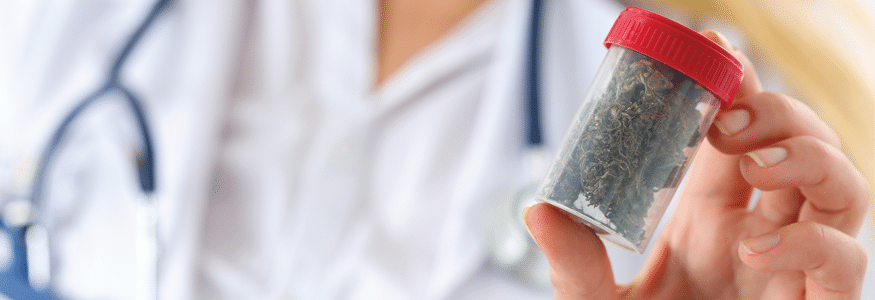
Medical Cannabis and IBD
Note: This is an older article about Medical Cannabis, originally published in the Inside Tract® in 2013. To read our updated article from 2018, and to watch our video on Medical Cannabis, click here.
At a BadGut® Lecture in Vancouver a few years ago, an inflammatory bowel disease (IBD) patient asked about the use of marijuana to treat his disease-associated pain. The gastroenterologist lecturer laughed and asked, “Where else but in Vancouver would someone ask this kind of question?” This person is not alone; many Canadians who have painful digestive conditions wonder if marijuana could help reduce their symptoms, particularly when nothing else seems to be working.
Currently, the amount of solid research on cannabis’s medical potential is limited, partly because there are so many strains with variable and changing potency, and partly because of limited ability to patent cannabis. In most countries, the illegal status of cannabis prevents researchers from conducting adequate studies.1 In spite of the lack of evidence, many Canadians have strong views on the subject, from those who believe pot can cure everything, to those who believe it is a harmful drug with nothing positive to offer. In this article, we will differentiate research from speculation and explain what the evidence shows about cannabis for the treatment of IBD.
What is Cannabis?
People have been cultivating numerous strains of the cannabis plant for thousands of years with different purposes in mind. When we develop the plant to grow tall and strong with thick fibrous stalks and a very small amount of cannabinoids (the active compounds in the plant) we call it hemp; people mostly use hemp seeds for food and its fibres for industrial purposes. When bred to have lush leaves and flowers that are high in cannabinoids, cannabis is used for medicinal or recreational purposes. Plant breeders have created innumerable different strains of cannabis, each of which has a different combination of cannabinoids, with variable potency results. Two common cannabinoids have been the subject of most research for IBD:
- Delta-9-tetrahydrocannabinol (THC), the most recognized cannabinoid, is associated with reduced nausea and pain, increased appetite (the munchies), and psychological effects such as relaxation, euphoria, and altered sensory perception, which are responsible for making users feel high or intoxicated. THC is also associated with negative psychological effects, such as irritability, anxiousness, and paranoia.
- Cannabidiol (CBD) does not produce intoxicating effects (non-psychotropic) but it is responsible for the sedative effects sometimes experienced when smoking or ingesting cannabis. CBD is associated with reduced convulsions, nausea, and inflammation. It might also lessen some of the negative symptoms associated with THC.2
Reefer Madness?
A Brief History of Cannabis
Historic evidence reveals that people have been using the cannabis plant since around 8,000 BCE, by making hemp rope and textiles and eating hemp seeds. It might have been one of the first agricultural crops! Earliest records of cannabis use as a medicine go back to China in 2,737 BCE, where Emperor Shen Nung recommended cannabis tea to heal a variety of ailments.
From there, this humble herb has spread its way around the globe. Shamans from several ancient cultures including the Scythians, Thracians, and Dacians used cannabis to help them enter trances. The ancient Egyptians used cannabis to relieve pain from hemorrhoids. Hindus in ancient India used ganja (another name for cannabis) for spiritual and medicinal purposes. More recently, there is evidence that William Shakespeare and Queen Victoria both used the plant. Marijuana was even popular in the US until the early 20th century, when consumers could purchase it from general stores and pharmacies as a medicine.
Today, the cannabis plant is still widely in use as hemp to make paper, clothing, jewellery, rope, strong textiles (the word ‘canvas’ comes from cannabis), biodegradable plastics, insulation, and even fuel. We also eat its nutritious seeds, which have become increasingly popular for making non-dairy milk alternatives, as well as a number of other foods such as hemp oil and hemp butter.
Marijuana remains an extremely popular drug worldwide for recreational and medicinal purposes. Its harvested and dried buds and leaves can be smoked, vapourized, eaten, made into tinctures, or concentrated into a resin called hash or hashish. Even though it is illegal in many places, more than 40% of Canadians claim to have “smoked up” at some point.3
Cannabis’s medicinal potential is gaining interest, as research points to its potential in treating a vast range of problems, including nausea, lack of appetite, pain, insomnia, premenstrual syndrome, IBD, migraines, epilepsy, certain mental disorders, glaucoma, asthma, multiple sclerosis, and many more ailments. It is possible to obtain medical marijuana legally in Canada under certain circumstances. See the section below on Medical Cannabis in Canada for more information.
Cannabis and IBD
The Endocannabinoid System (ECS)
To understand why marijuana might be beneficial for IBD, it is useful to have a basic knowledge of the endocannabinoid system. The ECS helps our bodies regulate pain, mood, appetite, gastrointestinal (GI) motility, memory, emotions, stress response, immune function, and more. The ECS is a complex combination of endocannabinoids (cannabinoids that our bodies naturally produce) that stimulate the body’s cannabinoid receptors, which are located in many areas of the body, such as the brain, muscles, fat (adipose tissue), and the entire GI tract. When a person ingests THC and/or CBD, which are similar molecular shapes to endocannabinoids, they fit into the same receptors and trigger reactions that result in either very high or very low levels of specific molecules that the brain’s cells use to communicate with one another (neurotransmitters). This is important because a growing body of research suggests that the functioning (or lack of functioning) of the ECS has an important relationship to the pathology of IBD.
Inflammation
To date, most research around the effects of marijuana (or its THC and CBD compounds) on IBD has involved studies with animals or biopsied human tissue. The results look promising, but warrant additional research and human studies before we can really understand how effective these substances might be.
In one study,4 researchers induced intestinal inflammation (colitis) in rodents and then tested the effectiveness of THC and CBD compared to sulphasalazine (one of the longest-used anti-inflammatory medications) on relieving the associated inflammation. The results showed that THC was most effective of the three when used on its own at a sufficient dose, CBD was ineffective on its own, and sulphasalazine was only slightly effective. Interestingly, the researchers found a synergetic effect when they combined a lower dose of THC (that they knew was ineffective on its own) with CBD; this treatment was even more beneficial than the previously noted effective dose of THC alone. This could mean that a future treatment that combines a lower dose of THC with CBD might be safer and have fewer side effects than a treatment with a higher dose of THC, since CBD does not cause intoxication. Unlike sulphasalazine, THC alone and combined with CBD also improved the function of colonic muscle movement.
In another animal study,5 researchers used several different methods to test the effectiveness of CBD alone at reducing inflammation in colitis. They found that administering CBD after inducing inflammation reduced it and that administering CBD before inducing inflammation prevented it from occurring at all. Using biopsies from individuals with ulcerative colitis, they also found that CBD was an effective anti-inflammatory agent, whether the biopsy was from a patient in remission or experiencing active disease. The researchers found that CBD affects certain cells (enteric glial cells) that are the first line of defence against harmful pathogens. In the presence of pathogens, these cells normally stimulate the inflammatory process by manufacturing a specific protein but CBD modulates its production, thereby reducing inflammation in the GI tract.
Crohn’s Disease
In a small retrospective observational study,6 researchers asked 30 Crohn’s disease patients in Israel a number of questions about the severity of their symptoms, any past surgeries and medical treatments, and their reasons for using marijuana. Where possible, the researchers compared this information with medical documents (hospitalization and medication use records), to find objective signs of disease severity.
The patients typically smoked the marijuana, with an average dose of 1-3 joints (rolled marijuana cigarettes) daily. All of the participants reported that marijuana had a positive effect on their disease severity, and of the 30 patients, 21 reported significant improvement of symptoms.
One of the more significant objective results from the study was the reduction in medications required to manage Crohn’s disease symptoms. Many participants required fewer prescription medications while using marijuana, and nine were able to stop using all other IBD medications. (See table.) As a group, the participants required slightly fewer surgeries while taking marijuana than they had previously. The participants also reported a reduced average number of daily bowel movements following marijuana use – from an average of eight down to five daily bowel movements per patient.
This study, while promising, has a number of weaknesses, such as the inherent unreliability of patient recollection, the inability of the researchers to measure the potency or effectiveness of specific cannabinoids, and the lack of data on the long-term positive (and possibly negative) effects of marijuana treatment for Crohn’s disease.
| Medical Treatment Before & After Marijuana Use (n=30)6 | ||
| Medication | Before | After |
| No treatment | None | 9 |
| 5-ASA | 27 | 5 |
| Corticosteroids | 26 | 4 |
| Thiopurine | 20 | 10 |
| Methotrexate | 6 | 0 |
| Anti-TNFα (biologics) | 12 | 4 |
In a more reliable, but still small, prospective placebo-controlled study,7 also from Israel, researchers studied 21 Crohn’s disease patients with active disease who did not respond to other available therapies. Half of the participants smoked marijuana twice daily in the form of cigarettes containing 11.5 mg of THC, while the other half smoked a placebo cigarette with no active ingredients. The researchers assessed disease activity and laboratory tests during the eight weeks of treatment and then two weeks later. Of the 11 participants taking cannabis, 5 of them achieved complete remission compared to only 1 of the 10 placebo participants. This study is very positive, but it included very few participants and the researchers say their results warrant larger studies.
Dangers and Adverse Effects
Despite its widespread use, the long-term negative effects of cannabis use are not clear. The amount of research conducted on this topic is currently very low, and many of the published studies are conflicting or of poor quality. There is much debate in the medical field over possible complications, including cannabinoid hyperemesis syndrome14,15,16, worsened psychological issues,17 onset of anxiety or paranoia, psychosis,18 a drop in IQ,19,20 and psychological addiction.21 Many of these issues remain controversial and are a popular source of debate among researchers. Pregnant women should avoid cannabis because it might pose risks to their fetuses.
We do have a better knowledge of short-term negative side effects (ones that occur only while the user is intoxicated). These include temporary impairment of short-term memory and concentration, increased anxiety or paranoia, lowered blood pressure, increased heart rate (posing risk for individuals with current heart problems), and impaired motor skills. These effects make it dangerous to use marijuana while driving.22
Since there is no government or manufacturer oversight of marijuana purchased illegally, it could contain a variety of other, potentially dangerous ingredients (e.g., phencyclidine (PCP), lead particles, etc.) unknown to the user. Never purchase cannabis illegally or take it unless your physician recommends it.

2017 Update on Medical Cannabis in Canada
We initially published this article in 2013. Since then, public opinions of cannabis have continued to shift dramatically, causing changes to the way patients access this medicine. An increasing number of states in the United States have been legalizing medical or recreational cannabis. In Canada, a 2016 poll found that 68% of Canadians support the legalization or decriminalization of marijuana,26 but it is currently illegal in Canada if you do not have a medical marijuana license.
New Legislation for Cannabis
As part of their 2015 election platform, the Trudeau government announced its intention to legalize cannabis for non-medical purposes. In 2016, the Honourable Dr. Jane Philpott, Federal Minister of Health, announced that the government would introduce legislation for legalization in the spring of 2017. However, in the meantime, individuals caught growing or possessing marijuana without proper authorization can face criminal charges.
How to Access Cannabis Now
Canada has had three different medical cannabis access regimes over the past two decades. In August 2016, Health Canada introduced the current Access to Medical Purposes Regulations (ACMPR). Under the ACMPR, physicians can authorize patients to legally access cannabis on the basis of a ‘medical document’. Patients can use the ‘medical document’ to either register with one of the 35+ licensed producers or with Health Canada to grow their own supply (or to designate someone to grow for them). Health Canada authorizes licensed producers to grow various medical cannabis strains in a tightly regulated environment with high standards for safety and potency testing. These producers can sell medical cannabis in either its dried flower form or as ingestible oils. Patients place orders (up to their monthly authorized dose) directly with the licensed producer, who then ships the medicine directly to their residence via courier.
Cannabis Buyer Beware
At this point in time, any retail point of access, including compassion clubs and dispensaries, operate outside the regulations and are not legal. These outlets often sell products the producers cannot (i.e., edibles), however, they are generally unable to test their products, which can create potential safety concerns in addition to their legal status.
IBD Patients and Canada
If you have IBD and are interested in trying medical cannabis, do not stop taking your prescribed medications. Instead, talk to your physician about the risks and benefits for your situation and for help applying for access to Health Canada’s medical cannabis program.
5 Interesting Facts about Marijuana
- Occasional marijuana smoking does not seem to cause problems with lung function. Unlike tobacco cigarettes, research shows that casual toking may actually increase lung capacity.8 However, this effect diminishes when smoking heavier amounts of marijuana.
- Unlike almost every other drug, legal or illegal, it is virtually impossible to die from an overdose of marijuana in its natural state. There is no recorded evidence that a person has ever died from marijuana toxicity alone, and researchers estimate that someone would have to eat or smoke impossibly high amounts of the plant in order to overdose. However, synthetic cannabinoids are not as safe.9,10 Of course, the intoxicating effects of marijuana on behaviour can lead to poor choices, which could result in harmful situations.
- Marijuana does not contain nicotine, but some individuals roll it up with tobacco before smoking it. This is relevant because research has shown that nicotine can sometimes improve ulcerative colitis symptoms while it can worsen Crohn’s disease symptoms.11
- Research suggests that occasional marijuana use could have a protective effect against brain damage caused from binge drinking.12
- Taking cannabis while on opioids may reduce pain without raising opioid blood levels, allowing patients to take less medication.13
Note: As of March 2017, the Gastrointestinal Society is on the Patient Advisory Committee of the Canadian Medical Cannabis Council (CMCC).




